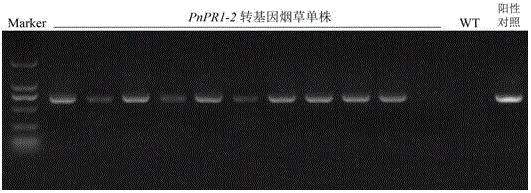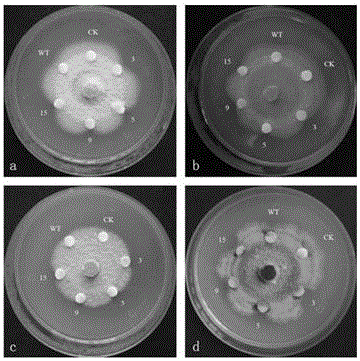Pathogenesis-related protein 1 family gene PnPR1-2 of panax notoginseng and application of pathogenesis-related protein 1 family gene PnPR1-2
A technology related to protein and disease course, applied in the fields of application, genetic engineering, plant genetic improvement, etc., can solve the problems of long period of breeding resistant varieties, time-consuming and laborious farming system, and high chemical pesticide residues, so as to shorten the breeding period and save costs. , the effect of broad market application prospects
- Summary
- Abstract
- Description
- Claims
- Application Information
AI Technical Summary
Problems solved by technology
Method used
Image
Examples
Embodiment 1
[0021] Example 1: PnPR1-2 Full-length gene cloning and sequence analysis
[0022] The roots of annual Panax notoginseng were inoculated with Fusarium solani rot, and total RNA was extracted from the roots 12 h after inoculation. Use reverse transcriptase M-MLV (promega) to synthesize the first strand of cDNA using total RNA as a template. The reaction system and operation process are as follows: Take 5 μg TotalRNA, add 50 ng oligo (dT), 2 μL dNTP (2.5mM each) in sequence , DEPC water to a reaction volume of 14.5 μL; after mixing, heat and denature at 70°C for 5 minutes, then quickly cool on ice for 5 minutes, then add 4 μL 5×First-standbuffer, 0.5 μL RNasin (200U), 1 μL M- MLV (200U), mix well and centrifuge for a short time, incubate at 42°C for 1.5 h, take it out and heat at 70°C for 10 min to terminate the reaction. After the first strand of cDNA was synthesized, it was stored at -20°C for future use.
[0023] Use the synthesized first-strand cDNA as a template to amplif...
Embodiment 2
[0025] Embodiment 2: plant overexpression vector construction
[0026] Use the SanPrep column plasmid DNA mini-extraction kit (Shanghai Sangong) to extract the insert PnPR1-2 coli plasmid pGEM-T- PnPR1-2 As well as the plasmid of the plant expression vector pCAMBIA2300s, take 1 μL for agarose gel electrophoresis to detect the integrity and concentration of the extracted plasmid; Bam HI (TaKaRa) and Eco RI (TaKaRa) respectively on the plasmid pGEM-T- PnPR1-2 and pCAMBIA2300s for double enzyme digestion (100 μL system), the reaction system and operation process are as follows: take 20 μL pGEM-T- PnPR1-2 and pCAMBIA2300s plasmid, respectively add 10 μL 10×Kbuffer, 5 μL BamHI , 5 μL Eco RI, 60 μL ddH 2 O, mix well and then centrifuge for a short time, and place it at 37°C for overnight reaction; spot all the digested products on agarose gel for electrophoresis, and then separate PnPR1-2 The fragments and the large fragments of the pCAMBIA2300s vector were recovered b...
Embodiment 3
[0029] Example 3: Plant genetic transformation mediated by Agrobacterium and screening of transgenic plants
[0030] The transgenic recipient in this experiment is tobacco. Soak the tobacco seeds in 75% alcohol for 30s, wash them with sterile water and wash them with 0.1% HgCl 2 Soak for 8 minutes, then wash several times with sterile water, sow on 1 / 2 MS medium, culture in dark at 28°C for 6 days, transfer to light incubator (25°C, 16h / d light) after germination, and then monthly Subculture once with 1 / 2 MS medium.
[0031] Take out the pCAMBIA2300s- containing pCAMBIA2300s- PnPR1-2 The plasmid Agrobacterium LBA4404 strain was inoculated in 5 mL of LB liquid medium containing 50 mg / L Km and 20 mg / L rifampicin, and cultured at 28°C until the medium was turbid. Pipette 1 mL of turbid bacterial solution onto LB solid medium containing 50 mg / L Km, and incubate at 28°C for 48 h; then scrape off the Agrobacterium on LB solid medium and inoculate it in an appropriate amount of ace...
PUM
 Login to View More
Login to View More Abstract
Description
Claims
Application Information
 Login to View More
Login to View More - R&D
- Intellectual Property
- Life Sciences
- Materials
- Tech Scout
- Unparalleled Data Quality
- Higher Quality Content
- 60% Fewer Hallucinations
Browse by: Latest US Patents, China's latest patents, Technical Efficacy Thesaurus, Application Domain, Technology Topic, Popular Technical Reports.
© 2025 PatSnap. All rights reserved.Legal|Privacy policy|Modern Slavery Act Transparency Statement|Sitemap|About US| Contact US: help@patsnap.com



